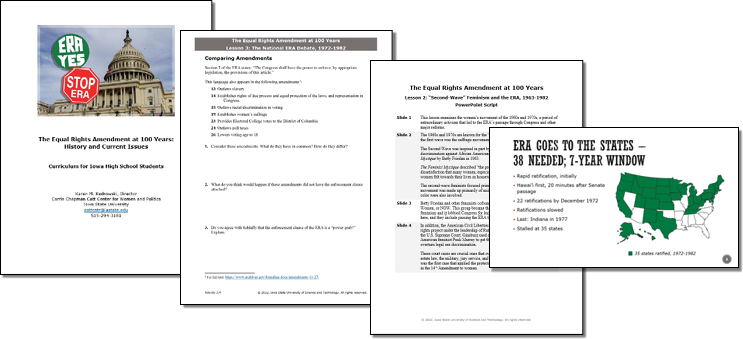Karen M. Kedrowski, director of the Carrie Chapman Catt Center for Women and Politics, recently published “The Equal Right Amendment: 100 Years of History and Current Issues.”
The research-based curriculum for Iowa high school students includes five lessons that cover the history and debates surrounding the Equal Rights Amendment (ERA) from the 1920s to the present. It also includes student learning outcomes, a list of Iowa Social Studies curriculum standards met, PowerPoint slides with suggested scripts, possible classroom activities and discussion questions, a list of additional resources, and background reading for instructors.
Celebrating the 100th anniversary of the 19th Amendment’s ratification in 2020 was what sparked the idea for Kedrowski to develop the curriculum. Shortly after the anniversary, she sent a proposal to the 19th Amendment Centennial Commemoration Committee, a state-wide coalition that coordinated events in Iowa to celebrate the centennial of the 19th Amendment’s ratification. The committee agreed to fund the project, and Kedrowski got to work on it.
Her research included reading background materials and academic literature, looking at historical newspapers, and examining papers at the Iowa Women’s Archive at the University of Iowa. The process took Kedrowski about eight months.
Brief history of the ERA
First introduced in Congress in 1923, the Equal Rights Amendment reads:
“Equality of rights under the law shall not be denied or abridged by the United States or by any state on account of sex. The Congress shall have the power to enforce, by appropriate legislation, the provisions of this article.”
Nearly a century later, the ERA has not been added to the Constitution. It was approved by Congress in 1972, but only 35 of the required 38 states ratified it before the deadline of March 22, 1979, set by Congress. The deadline was then extended by three years, but no other states ratified the amendment during that time. Since 2017, three more states have ratified it—Nevada in 2017, Illinois in 2018 and Virginia in 2020.
Arguments and lawsuits over both the constitutionality of the deadline set by Congress and whether states should be allowed to rescind their ratification (five states rescinded after their initial ratification and a sixth rescinded in 2021) have prevented the head of the National Archives and Records Administration, the government organization charged with keeping the official ratification count, from adding the amendment to the Constitution.
The debate
There is widespread debate in Congress and among many other groups on whether the ERA should be passed. Doris Kelley, chair of the 19th Amendment Centennial Commemoration Committee and former Iowa state representative, noted that Congress has been debating not only the amendment but also terms such as “equal” and “equality” and what that refers to.
Opponents of the ERA think that it should not be put into the Constitution because the U.S. already has the 14th Amendment equal protection clause, which some think already protects women. That amendment states:
“All persons born or naturalized in the United States, and subject to the jurisdiction thereof, are citizens of the United States and of the state wherein they reside. No state shall make or enforce any law which shall abridge the privileges or immunities of citizens of the United States; nor shall any state deprive any person of life, liberty, or property, without due process of law; nor deny to any person within its jurisdiction the equal protection of the laws.”
For decades, opponents also thought that by passing the Amendment, laws that protect men and women differently would not pass, such as in cases of insurance, divorce and war. Currently, opponents argue, variously, that the ERA is not needed because women have achieved equality without it and that the ERA would provide a constitutional protection for abortion. On the other hand, some think passing the ERA would be a symbol of women’s fight for equality ending, which to their argument, could be bad because not only do laws have to change, but society does, too.
People for the ERA think it is necessary to put it into the Constitution to guarantee that all citizens, regardless of gender, are treated equally under the law. The ERA would also set a clear legal precedent in the courtroom for cases of discrimination based on sex. It could also improve different facets of life, such as businesses being more competitive by having more gender diversity in leadership, improving pay equality, women-owned businesses getting equal access to capital, and less legal distinction between men and women.
ERA curriculum illustrates the process and issues

The curriculum is important to make students aware of the history and current status of the ERA, as many Americans mistakenly believe the ERA has passed, according to the ERA Education Project.
It is structured so that “students will be able to decide—on their own accord—whether the ERA should be enacted,” Kelley said, adding that “almost 78% of Americans believe that the ERA should be a part of the Constitution.”
The curriculum is free for use by any school district and available on the Catt Center’s website at https://go.iastate.edu/V1L7MT.
In addition, Kedrowski will be facilitating a free professional development workshop for social studies teachers on Feb. 18 at Iowa State University. Registration for the workshop is required by noon on Feb. 3 at https://go.iastate.edu/YCUNBA. Lunch will be provided.
Works Cited
briefpolicyperspectives. 2019. “Arguments for and against the Equal Rights Amendment.” Policy Perspectives. November 21. https://policy-perspectives.org/2019/11/21/arguments-for-and-against-the-equal-rights-amendment.
“What is the Equal Rights Amendment?” n.d. ERA Education Project. https://eraeducationproject.com/what-is-the-equal-rights-amendment.
Article by Clare Vilmont, Catt Center public relations and events planning intern